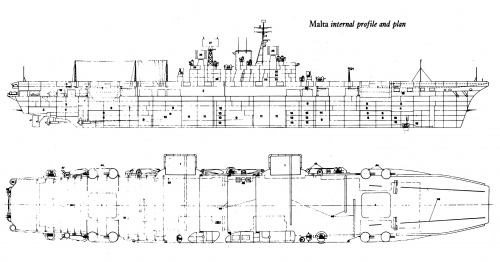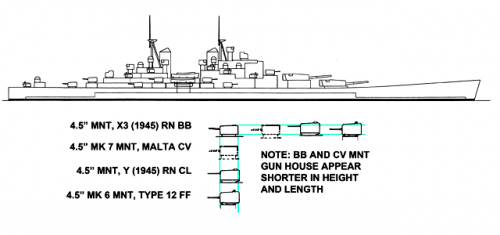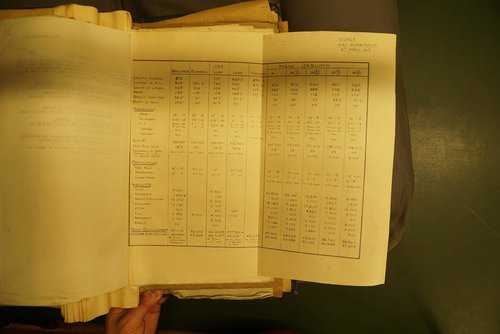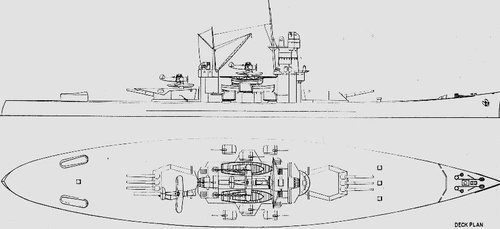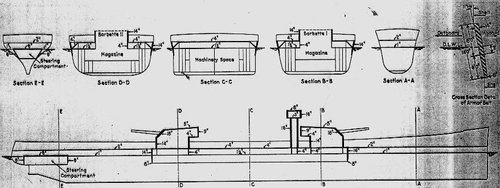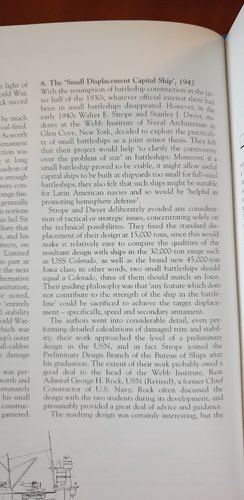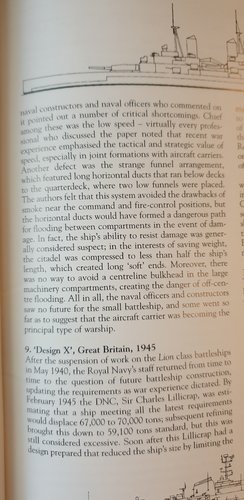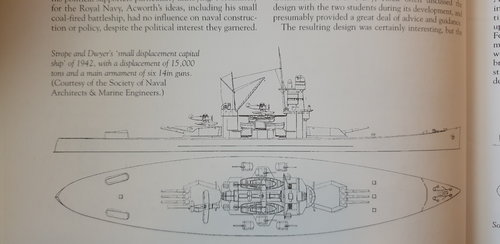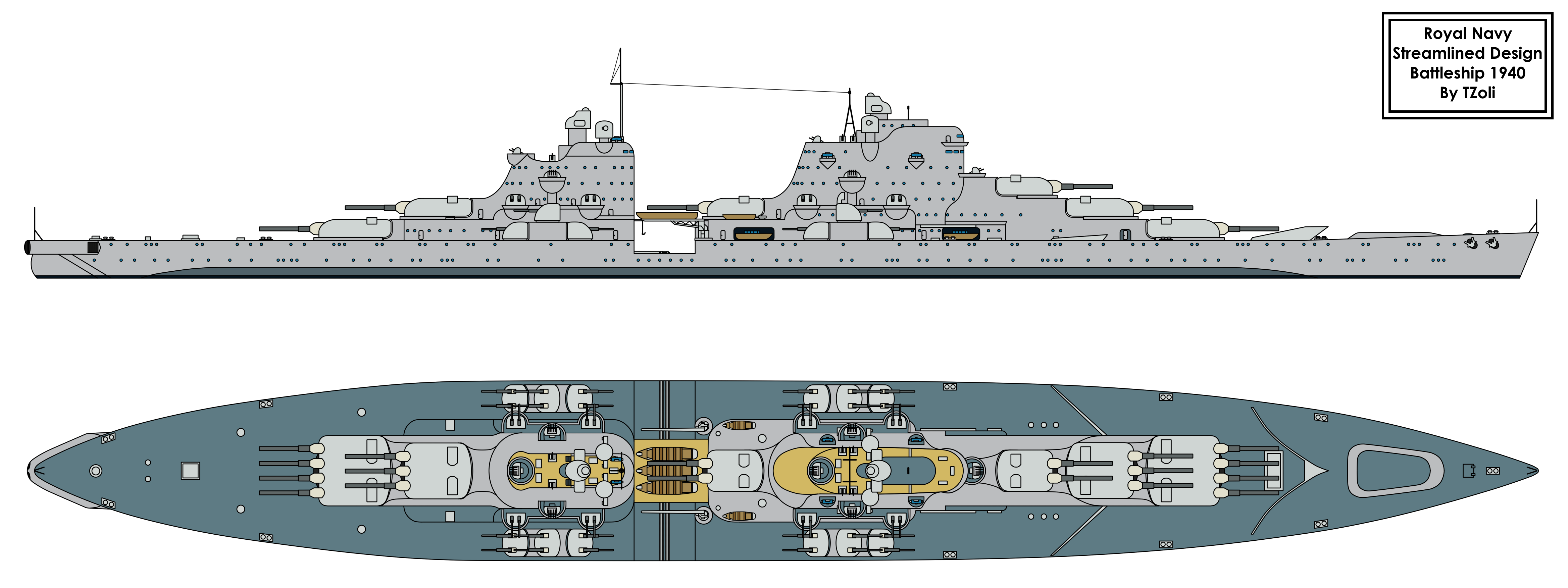How the United States Navy perceived the likely post-War line up (pre-Truman and Attlee):
This link is essentially dead. Any chance someone has it archived?
My dear
that_person, I am the person in question who posted it there.
Post-War Navy, 1945; James V. Forrestal Papers, Box 135, Folder 3; Public Policy Papers, Department of Rare Books and Special Collections, Princeton University Library
Collection: James V. Forrestal Papers
Call Number: MC051
Box 135
Folder 1 to 3
Find it online: https://findingaids.princeton.edu/collections/MC051/c04915 |
SECRET
BRITISH-UNITED STATES POST-WAR NAVIES
British Empire
The British Empire after the war (with completion of the present building program) will have 14 battleships and 1 battle cruiser, of which 5 battleships will be modern, high-speed ships:
Modern (5) | Older Vessels (10) |
*VANGUARD
HOWE
ANSON
DUKE of YORK
KING GEORGE V
* (Completes about December, 1945) | NELSON
RODNEY
MALAYA
VALIANT
QUEEN ELIZABETH
WARSPITE
RAMILLES
RESOLUTION
REVENGE
RENOWN (Battle Cruiser ) |
The British Empire will have about 32 carriers if the present building program is carried out. At the present time the carrier force is 10 in number, and includes the following:
Fleet Carriers (6)
(23,000 tons) | Light Fleet Class (CVL) (3)
(14,000 tons) |
ILLUSTRIOUS
INDOMITABLE
VICTORIOUS
FORMIDABLE
IMPLACABLE
INDEFATIGABLE | COLOSSUS
VENERABLE
VENGEANCE |
| Old Carrier (1) |
| FURIOUS |
The following British carriers (22 in number) are building. These include 11 carriers of the 14,000-ton COLOSSUS Class (to complete in 1945 and 1946);
8 carriers of the 18,310-ton HERMES Class (to complete in 1946, 1947 and 1948; and 3 carriers of the 33,000-ton ARK ROYAL Class (to complete in 1947 or later):
(11)
COLOSSUS Class
(14,000 tons) | (8)
HERMES Class
(18,310 tons) | (3)
ARK ROYAL Class
(33,000 tons) |
GLORY
HERCULES
LEVIATHAN
MAJESTIC
OCEAN
THESEUS
TRIUMPH
WARRIOR
MAGNIFICENT
POWERFUL
TERRIBLE | ALBION
ARROGANT
BULWARK
CENTAUR
HERMES
MONMOUTH
ELEPHANT
POLYPHEMUS | ARK ROYAL
EAGLE
AUDACIOUS |
The British Empire will have about 41 escort carriers, of which 35 were obtained through Lend-Lease from the United States.
The British will have 12 heavy cruisers, of which 10 are fairly modern.
They will have 57 light cruisers (six of them to complete in 1945 and 1946) of which 39 can be considered modern.
The Royal Navy will have about 376 destroyers (104 of these are building or are projected) of which only about 40 will be of some 2300 tons.
The Royal Navy will also have about 162 submarines (of which 45 are now building and 8 are now overage).
UNITED STATES
The preliminary demobilisation study for the post-war Navy assumes two broad categories:
1. An active Navy in full commission.
2. A Navy in reduced commission in reserve.
I
Naval Facilities
1. The active Navy will comprise three fleets, each consisting of:
5 carriers;
3 battleships;
8 cruisers (1 CB, 3 CA, 4 CL);
27 destroyers;
and auxiliaries comprising:
1 AR (Repair);
1 AD (Destroyer Tender);
3 AO (Oiler);
1 AH (Hospital);
2 AF (Provisions).
Attached to each active fleet will be 1 amphibious force, comprising:
1 Amphibious Brigade of Marines;
1 AP;
4 APA;
2 AKA.
Thus the active Navy will comprise, for planning purposes:
9 battleships;
15 carriers;
3 battle cruisers (Alaska Class);
9 heavy cruisers;
12 light cruisers;
81 destroyers.
and auxiliaries comprising:
3 AR (Repair);
3 AD (Destroyer Tender);
9 AO (Oiler);
3 AH (Hospital);
6 AF (Provisions);
and amphibious forces comprising:
3 Amphibious Brigades of Marines;
3 AP;
12 APA;
6 AKA.
2. In the second category, the Navy in so-called "reduced commission in reserve" will consist of 2 fleets, each having:
4 carriers (3 CV, 1 CVL);
3 battleships;
4 heavy cruisers;
4 light cruisers;
27 destroyers;
and auxiliaries comprising:
1 AR (Repair);
1 AD (Destroyer Tender);
3 AO (Oiler);
1 AH (Hospital);
2 AF (Provisions).
The totals for the Navy in so-called "Reduced commission in reserve" will therefore be:
8 carriers (6 CV, 2 CVL);
6 battleships;
8 heavy cruisers;
8 light cruisers;
54 destroyers;
plus auxiliaries, as follows:
2 AR (Repair);
2 AD (Destroyer Tender);
6 AO (Oiler);
2 AH (Hospital);
4 AF (Provisions).
3. Associated with these fleets there will be:
(a)
3 detached task forces, each
2 carriers;
4 light cruisers;
18 destroyers;
plus the following auxiliaries:
1 AO (Oiler);
1 AD (Destroyer Tender);
1 AF (Provisions),
The
totals in these
task forces will therefore be:
6 carriers;
12 light cruisers;
54 destroyers;
3 AO (Oiler);
3 AD (Destroyer Tender);
3 AF (Provisions).
(b)
3 submarine and anti-submarine units, each comprising:
30 SS;
2 AS (submarine Tender);
20 DE;
2 CVE;
6 Submarine Chasers (110');
6 Submarine Chasers (173');
12 Motor Torpedo Boats;
1 AO (Oiler).
The
totals for the
submarine and anti-submarine units will therefore be:
90 SS;
6 AS (submarine Tender);
60 DE;
6 CVE;
18 Submarine Chasers (110');
18 Submarine Chasers (173');
36 Motor Torpedo Boats;
3 AO (Oiler).
(c)
3 Mine Divisions, comprising:
1 CM (Minelayer);
2 DM (Light Minelayer);
6 AM (Minesweeper);
2 AN (Net Layer).
The
totals for the
Mine Divisions will therefore be:
3 CM (Minelayer);
6 DM (Light Minelayers);
18 AM (Minesweepers);
6 AN (Net Layer).
Recapitulation
4.
Heavy units of the whole naval establishment will therefore comprise:
15 battleships;
29 carriers;
3 battle cruisers;
17 heavy cruisers;
32 light cruisers.
The
lighter combatant vessels will consist of:
189 destroyers;
60 destroyer escorts;
6 escort carriers;
90 submarines.
The total
auxiliaries will consist of:
5 AR (Repair);
8 AD (Destroyer Tender);
21 AO (Oiler);
5 AH (Hospital);
13 AF (Provisions);
3 AP (Transport);
12 APA (Transport, Attack);
6 AKA;
6 AS (Submarine Tender);
18 PC (Submarine Chaser, 110');
18 SC (Submarine Chaser, 173');
36 PT (Motor Torpedo Boat);
3 CM (Minelayer);
6 DM (Light Minelayer);
18 AM (Minesweeper);
6 AN (Net Layer).
II
Marine Corps
The Marine Corps will comprise 2 combat divisions and 5 amphibious brigades, in addition to the Fleet Marines, Guards, and Air, for a total of 131,000.
III
Air
Total operating planes are projected at 8,302 with a 50 percent reserve of spares of 4,151, making a total of 12,453.
IV
Personnel
For planning purposes two alternatives have been selected for manning of the Navy.
1. The first assumes all active ships and stations and other auxiliary units are to be manned at full war complement, with the ships in reduced commission at 20 percent of war complement.
2. The second assumes all active ships manned at 75 percent of war complement with ships in reduced commission at 20 percent of war complement.
Both assumptions include such personnel for the Air Arm as may be necessary for efficient operations and for maintenance of fleets on an efficient basis.
Under (1) the officers and men required would total 612,178. Of this number 64,093 would be officers, of whom 23,000 would be candidates for officers’ commissions.
Under (2) the requirements would be 509,401 officers and men of whom 39,114 would be officers, including 18,000 officer candidates.
V
Financial Requirements
1. The annual outlay under the second assumption (75 percent of war complement for the active Navy and 20 percent for ships in reserve - Paragraph IV(2)) would be $4,549,000,000.
2. Under the first assumption (Paragraph IV(1)) the amount would be somewhat over $5 billion.
VI
Lay-Up Facilities
If we are to keep the number of ships involved under these assumptions substantial additional berthing facilities will be required.
VII
Discarded Vessels
If we take these assumptions as the maximum Navy which the nation can keep and maintain after the war we shall have to provide for the scrapping or disposition otherwise of the following ships in the various classes:
Battleships
Assuming:
A. | B. | C. |
Retention in full and reduced commission of: | Laying up in an "out of commission" status: | Recommended we scrap: |
1. BB-66 KENTUCKY
2. BB-65 ILLINOIS
3. BB-64 WISCONSIN
4. BB-63 MISSOURI
5. BB-62 NEW JERSEY
6. BB-61 IOWA
7. BB-60 ALABAMA
8. BB-59 MASSACHUSETTS
9. BB-58 INDIANA
10. BB-57 SOUTH DAKOTA
11. BB-56 WASHINGTON
12. BB-55 NORTH CAROLINA
13. BB-48 WEST VIRGINIA
14. BB-44 CALIFORNIA
15. BB-43 TENNESSEE | 1. BB-46 MARYLAND
2. BB-45 COLORADO
3. BB-42 IDAHO
4. BB-41 MISSISSIPPI
5. BB-40 NEW MEXICO
6. BB-38 PENNSYLVANIA | 1. BB-36 NEVADA
2. BB-35 TEXAS
3. BB-34 NEW YORK
4. BB-33 ARKANSAS |
Note: WEST VIRGINIA, CALIFORNIA and TENNESSEE have been modernized and equipped with 5”/38 double purpose, hence their selection over MARYLAND and COLORADO.
Battle Cruisers
Assuming:
A. | B. | C. |
Retention in full and reduced commission of: | Laying up in an "out of commission" status: | Recommended we scrap: |
1. CB-3 HAWAII
2. CB-2 GUAM
3. CB-1 ALASKA | None | None |
Heavy Cruisers
Assuming:
A. | B. | C. |
Retention in full and reduced commission of: | Laying up in an "out of commission" status: | Recommended we scrap: |
1. CA-153
2. CA-152
3. CA-151
4. CA-150
5. CA-149
6. CA-148
7. CA-143
8. CA-142
9. CA-141
10. CA-140
11. CA-139
12. CA-138 SCRANTON
13. CA-137 NORFOLK
14. CA-136 CHICAGO
15. CA-135 LOS ANGELES
16. CA-134 DES MOINES
17. CA-133 TOLEDO | 1. CA-132 MACON
2. CA-131 FALL RIVER
3. CA-130 BREMERTON
4. CA-129 TULSA
5. CA-128 KANSAS CITY
6. CA-127 BRIDGEPORT
7. CA-126 CAMBRIDGE
8. CA-125 NORTHAMPTON
9. CA-124 ROCHESTER
10. CA-123 ALBANY
11. CA-122 OREGON CITY
12. CA-75 HELENA
13. CA-74 COLUMBUS
14. CA-73 ST. PAUL
15. CA-72 PITTSBURGH
16. CA-71 QUINCY
17. CA-70 CANBERRA
18. CA-69 BOSTON
19. CA-68 BALTIMORE | 1. CA-45 WICHITA
2. CA-38 SAN FRANCISCO
3. CA-37 TUSCALOOSA
4. CA-36 MINNEAPOLIS
5. CA-35 INDIANAPOLIS
6. CA-33 PORTLAND
7. CA-32 NEW ORLEANS
8. CA-31 AUGUSTA
9. CA-28 LOUISVILLE
10. CA-27 CHESTER
11. CA-25 SALT LAKE CITY
12. CA-24 PENSACOLA |
Light Cruisers
Assuming:
A. | B. | C. |
Retention in full and reduced commission of: | Laying up in an "out of commission" status: | Recommended we scrap: |
1. CL-159 *
2. CL-158 *
5. CL-157 *
4. CL-156 *
5. CL-155 *
6. CL-154 *
7. CL-147
8. CL-146 VALLEJO
9. CL-145 ROANOKE
10. CL-144 WORCESTER
11. CL-121 FRESNO
12. CL-120 SPOKANE
15. CL-119 JUNEAU
14. CL-118 CHATTANOOGA
15. CL-117 CHEYENNE
16. CL-116 TALLAHASEE
17. CL-111 WILMINGTON
18. CL-110 BUFFALO
19. CL-109 NEW HAVEN
20. CL-108 NEWARK
21. CL-107 HUNTINGTON
22. CL-106 FARGO
23. CL-105 DAYTON
24. CL-104 ATLANTA
25. CL-103 WILKES-BARRE
26. CL-102 PORTSMOUTH
27. CL-101 AMSTERDAM
28. CL-98 TUCSON *
29. CL-97 FLINT *
30. CL-96 RENO *
31. CL-95 OAKLAND *
32. CL-94 YOUNGSTOWN * | 1. CL-93 GALVESTON
2. CL-92 LITTLE ROCK
3. CL-91 OKLA. CITY
4. CL-90 ASTORIA
5. CL-89 MIAMI
6. CL-87 DULUTH
7. CL-86 VICKSBURG
8. CL-83 MANCHESTER
9. CL-82 PROVIDENCE
10. CL-81 HOUSTON
111. CL-80 BILOXI
12. CL-67 TOPEKA
13. CL-66 SPRINGFIELD
14. CL-65 PASADENA
15. CL-64 VINCENNES
16. CL-63 MOBILE
17. CL-62 BIRMINGHAM
18. CL-60 SANTA FE
19. CL-58 DENVER
20. CL-57 MONTPELIER
21. CL-56 COLUMBIA
22. CL-55 CLEVELAND
23. CL-54 SAN JUAN *
24. CL-53 SAN DIEGO * | 1. CL-49 ST. LOUIS
2. CL-48 HONOLULU
3. CL-47 BOISE
4. CL-46 PHOENIX
5. CL-43 NASHVILLE
6. CL-42 SAVANNAH
7. CL-41 PHILADELPHIA
8. CL-40 BROOKLYN
9. CL-15 MEMPHIS
10. CL-12 MARBLEHEAD
11. CL-11 TRENTON
12. CL-10 CONCORD
13. CL-9 RICHMOND
14. CL-8 DETROIT
15. CL-7 RALEIGH
16. CL-6 CINCINNATI
17. CL-5 MILWAUKEE
18. CL-4 OMAHA |
Notes: Asterisks indicate the so-called AA-type cruiser.
Aircraft Carriers, Large
Assuming:
A. | B. | C. |
Retention in full and reduced commission of: | Laying up in an "out of commission" status: | Recommended we scrap: |
1. CVB-57
2. CVB-56
5. CVB-43 | 1. CVB-42 CORAL SEA
2. CVB-41 MIDWAY | None |
Aircraft Carriers
Assuming:
A. | B. | C. |
Retention in full and reduced commission of: | Laying up in an "out of commission" status: | Recommended we scrap: |
1. CV-55
2. CV-54
3. CV-53
4. CV-52
5. CV-51
6. CV-50
7. CV-47
8. CV-46
9. CV-45 VALLEY FORGE
10. CV-40 TARAWA
11. CV-39 LAKE CHAMPLAIN
12. CV-38 SHANGRI LA
13. CV-37 PRINCETON
14. CV-36 ANTIETAM
15. CV-35 REPRISAL
16. CV-34 ORISKANY
17. CV-33 KEARSARGE
18. CV-32 CROWN POINT
19. CV-31 BON HOMME RICHARD
20. CV-21 BOXER
21. CV-20 BENNINGTON | 1. CV-19 HANCOCK
2. CV-18 WASP
3. CV-17 BUNKER HILL
4. CV-16 LEXINGTON
5. CV-15 RANDOLPH
6. CV-14 TICONDEROGA
7. CV-13 FRANKLIN
8. CV-12 HORNET
9. CV-11 INTREPID
10. CV-10 YORKTOWN
11. CV- 9 ESSEX | 1. CV-6 ENTERPRISE
2. CV-4 RANGER
3. CV-3 SARATOGA |
Aircraft Carriers, Small
Assuming:
A. | B. | C. |
Retention in full and reduced commission of: | Laying up in an "out of commission" status: | Recommended we scrap: |
1. CVL-49
2. CVL-48
3. CVL-30 SAN JACINTO
4. CVL-29 BATAAN
5. CVL-28 CABOT | 1. CVL-27 LANGLEY
2. CVL-26 MONTEREY
3. CVL-25 COWPENS
4. CVL-24 BELLAU WOOD
5. CVL-22 INDEPENDENCE | None |
Aircraft Carriers, Escort
At the end of the war (assuming completion of the present construction program and assuming no further losses) we will have a total of 98 escort carriers. Under the proposed plan 6 escort carriers will be retained in active commission, leaving 92 to be disposed of by:
(b) Sale for appropriate merchant marine uses;
It is recommended that the escort carriers (a) to be retained in active commission, and (b) in a laid-up status, be selected from the following (at present 28 in number):
CVE-26 to CVE-30, inclusive, and
CVE-105 to CVE-127, inclusive, plus any built subsequent to CVE-127.
Destroyers
At the end of the war (assuming completion of the present construction program and assuming no further losses) we will have a total of 524 Destroyers.
Under the proposed plant
1. Retain in active commission . . . . . . . . . 135
2. In "Reduced commission in reserve" . . . . .54
This will leave 355 destroyers to be disposed of by:
It is recommended that the destroyers to be retained in:
(b) "Reduced commission in reserve," and
be selected from ships numbered DD-351 to DD-850, inclusive, and that destroyers prior to DD-351 (now 39 in number) be scrapped.
Destroyer Escorts
At the end of the war (assuming completion of the present construction program and assuming no further losses) we will have a total of 366 destroyer escorts.
Under the proposed plan,
60 destroyer escorts will be retained in active commission, leaving
306 destroyer escorts for disposal by laying up or scrapping.
Submarines
At the end of the war (assuming completion of the present construction program and assuming no further losses) we will have a total of 319 submarines.
Under the proposed plan
90 submarines will be retained in active commission, leaving
229 submarines for disposal by:
JF:HCO
3-16-45
- - - - - - - - - - - - - - - - - - - - - - - - - - - - - - - - - - - - - - - - - - - - - - - -
Recapitulation
Assuming:
| A. | B, | C | D. |
| Maximum on hand at end of war (*) | Retention in full and reduced commission of: | Laying up in an “out of commission” status | Recommended we scrap: |
BB | 25 | 15 | 6 | 4 |
CB | 3 | 3 | 0 | 0 |
CA | 48 | 17 | 19 | 12 |
CL | 74 | 32 | 24 | 18 |
CVB | 5 | 3 | 2 | 0 |
CV | 35 | 21 | 11 | 3 |
CVL | 10 | 5 | 5 | 0 |
DD | 524 | 189 | 296 | 39 |
DE | 366 | 60 | 306 (#) | 0 |
CVE | 98 | 6 | 22 | 70 |
SS | 319 | 90 | 229 (#) | 0 |
Notes:
* – Assuming completion of present building program and assuming no further losses.
# – Recommend scrapping of such DE's and SS’s as suitable survey Boards may determine are beyond economical repair and upkeep.


